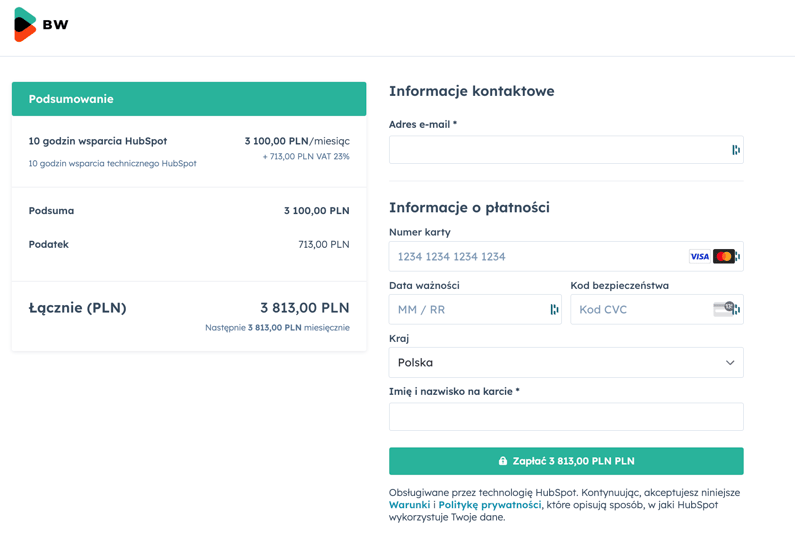Table of Contents
Prefer to listen rather than read? Play below 👌
How does HubSpot support ecommerce?
E-commerce (ecommerce) plays a key role in today's business, enabling companies to sell products and services on a global scale. However, in order to effectively manage commerce, advanced tools are required to automate sales, payment and customer service processes.
HubSpot Commerce Hub is a comprehensive solution designed to support the ecommerce sales process, which combines payment management, integration with popular ecommerce platforms and advanced analytics.
Although HubSpot offers ecommerce support tools, it does not have the full functionality of an online store and does not replace solutions such as WooCommerce or PrestaShop. It does, however, help automate processes on these platforms and offers ready-made integrations, although it does not have all their features.
Commerce Hub - ecommerce sales support
HubSpot Commerce Hub provides tools to support every stage of online sales. With its functionality, it focuses on the sale of single products and services, offering support for payment from contact forms, making appointments and issuing quotes. When selling a single service, it can help with payment processing and simple invoicing.
This allows businesses to effectively manage their operations, speed up payment processes and increase revenue. The key features of Commerce Hub are:
1. invoice management
HubSpot Invoices allows companies to quickly and professionally create and send invoices directly from within the CRM. The process is simple and automated.
It's worth remembering that HubSpot-generated invoices are simplified and do not replace full invoicing systems such as Invoice Works. HubSpot allows you to issue invoices, but corrections must be made outside the system. This works similarly to other systems that handle online sales; for example, when you buy something from a SaaS company, you often receive an invoice from Stripe, a document generated for the transaction.
Functionalities include:
- Creating invoices with company logos and personalized information.
- Real-time monitoring of payment status.
- Automatic payment reminders for defaulting customers.

2 Payment links
Payment links are a solution that makes it easier for customers to finalize purchases. Companies can generate unique payment links that can be shared via email, social media or websites. This makes the purchasing process simpler and more intuitive.
A payment link can also be integrated with a HubSpot form (e.g., paid webinar registration) or a HubSpot appointment (e.g., paid consultation). Within the payment link creation function we have:
- Quick link generation without the need for complex integration.
- Acceptance of various payment methods thanks to integration with the STRIPE function. You have the option to pay by card or bank transfer (manual)
- Easy sharing of links e.g. in an email message sent
You can see an example of a payment link here. We use Stripe payment integration. By clicking the link you will pay for nothing, you will see a screen to preview the transaction - HubSpot Payment Link

3. subscriptions
For companies offering products or services in a subscription model, HubSpot Commerce Hub provides tools for managing recurring payments. Functionalities include:
- Automation of subscription billing.
- Ability to customize subscription plans to meet customer needs.
- Monitoring and reporting of subscription performance.
- Automation of sending invoices for recurring payments
- Automation of subscription reminders
4 Integration with Stripe
HubSpot Commerce Hub works with popular payment gateways such as Stripe. This integration allows acceptance of a wide range of payment methods, including credit and debit cards. Functionalities include:
- A simple process for setting up integration with Stripe.
- Secure payment processing with cards and bank transfers (manual)
- Synchronization of payment data with CRM.
Integrations with ecommerce platforms
HubSpot Commerce Hub is fully compatible with leading ecommerce platforms such as Shopify, WooCommerce, PrestaShop and Magento. This makes it possible to synchronize order, product and customer data to centralize information and better manage customer relationships.
If you have your own ecommerce platform, for example, as a B2B sales portal or your own dedicated store. Integration with HubSpot is possible thanks to HubSpot's proprietary REST API. This interface provides full data exchange between the 2 systems. You can read about our approach to integration on the HubSpot Integrations service page and about integration costs on the HubSpot Integration Costs description page.
Integrations both off-the-shelf and built by HubSpot Interface offer:
Customer data exchange
HubSpot CRM collects customer data in one place, allowing access to complete profiles including order history, website activity, email interactions and other relevant information.
We get information about what products the customer is looking at in the store, what materials they are reading.
All this allows for more precise customer relationship management. Integration of data flow from the e-commerce platform to HubSpot in terms of data of new contacts or potential and completed transactions is provided. The database is synchronized online, so we can create real-time marketing automation activities.
Segmentation of lists and personalization of communications
HubSpot advanced segmentation capabilities allow you to create lists of customers, leads or people who have abandoned their shopping carts. You can apply an RFM strategy, automatically segmenting customers based on their shopping frequency or purchase size. This allows you to tailor your communications to different audiences, increasing the effectiveness of your marketing campaigns. A marketing automation module called HubSpot Workflow will help you do this.
Tracking and recovering abandoned shopping carts
HubSpot allows you to track which products have been added to shopping carts but not purchased. This allows you to implement strategies to recover abandoned shopping carts, such as sending email reminders or dedicated offers, to increase sales.
Email and marketing automation
You can create personalized, responsive emails that address specific customer needs based on their previous interactions. HubSpot 's marketing automation allows you to personalize communications, scale activities and automate processes based on customer behavior. Marketing automation in HubSpot is more than just emails, it's a comprehensive system that helps you manage tasks, change data or build automation scenarios based on ad clicks or email reads.
Ad management and advanced analytics
HubSpot makes it easy to create and manage ad campaigns on channels such as Facebook, Instagram, LinkedIn and Google. In addition, advanced e-commerce analytics allow you to monitor sales performance, identify areas for improvement and optimize the customer experience.
For analysis, you can use HubSpot's reporting module, as well as create custom reports using Custom Report Builder.
Integrating e-commerce with HubSpot is a solution that not only centralizes data, but also offers tools for automation, personalization and analysis. This allows you to grow your business, increase the effectiveness of your marketing efforts and build better relationships with your customers.
RFM strategy in e-commerce: how does HubSpot support its implementation?
The RFM (Recency, Frequency, Monetary) strategy is a proven method of customer segmentation that allows you to focus on those who have the greatest impact on your business. With RFM, you can better understand your customers and tailor your communications to their needs and behaviors. HubSpot, as an advanced CRM tool, perfectly supports the implementation of RFM strategies in your e-commerce business.
What is an RFM strategy?
RFM is customer analysis based on three key parameters:
- Recency (Last Activity): How recently a customer made a purchase or was active on your site.
- Frequency: How often a customer makes a purchase.
- Monetary (Purchase Value): How much value the customer generates over a certain period of time.
Based on these three factors, customers are segmented to determine which customers are most engaged and valuable to your business.
How does HubSpot support your RFM strategy?
HubSpot offers tools to help you successfully implement your RFM strategy by enabling you to analyze customer data and personalize your communications.
1. Data collection and centralization
By integrating with e-commerce platforms such as WooCommerce, Shopify and Magento, HubSpot automatically collects data on orders, customer activity and their purchase values. All this information is available in one place, in the customer profile.
2. Customer segmentation
HubSpot allows you to create advanced customer segments based on RFM criteria. You can easily identify:
- Customers who have recently made a purchase (Recency).
- Customers who make frequent purchases (Frequency).
- Customers with high order value (Monetary).
These segments allow you to tailor your communications to the needs of each customer group
3. Personalization of communication
HubSpot allows you to create personalized email campaigns and marketing automations that target the right groups of customers. For example:
- Loyalty campaigns for high Frequency customers.
- Special offers for high Monetary customers to encourage repeat purchases.
- Reminders and promotions for customers who have not made a purchase in a long time.
4. Performance analysis
With HubSpot 's advanced analytics tools, you can track how the implementation of your RFM strategy affects your e-commerce performance. HubSpot provides reports on customer behavior, campaign effectiveness and revenue generated.
Advantages of implementing an RFM strategy with HubSpot
- Precise targeting: Segmentation allows you to target messages to the most valuable customers.
- Increased ROI: Personalized campaigns allow you to better utilize your marketing budget.
- Better customer relationships: Regular and personalized communication builds customer loyalty.
- Process optimization: HubSpot automation reduces the time and resources needed to implement and maintain your RFM strategy.
RFM strategy is a powerful tool that helps e-commerce focus on the most valuable customers. With HubSpot's support, you can effectively implement this method by automating data analysis and adjusting marketing activities. Contact us to learn how implementing an RFM strategy with HubSpot can help your business increase sales and build long-term customer relationships.
Why choose HubSpot Commerce Hub?
HubSpot Commerce Hub is a powerful tool that supports ecommerce development with advanced payment management, integration and analytics. This allows businesses to increase efficiency, improve customer experience and achieve better financial results. Whether you run a small online store or a large ecommerce platform, HubSpot will provide you with the tools you need to succeed.
If you're running a simple product sale, integration with Stripe allows you to process payments via payment links, assign payments to a form or appointment, and the system can automatically generate invoices. You can also set up regular payments and invoices for customers in the form of subscriptions.
If you're using e-commerce platforms, you can integrate HubSpot with a number of available plugins. A REST API to HubSpot is available for your own platforms.
Do you have questions about e-commerce on HubSpot? Contact us and we'll be happy to answer all your questions and help you determine if HubSpot is right for you.

